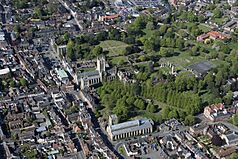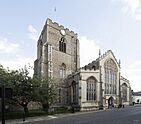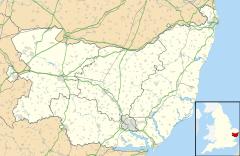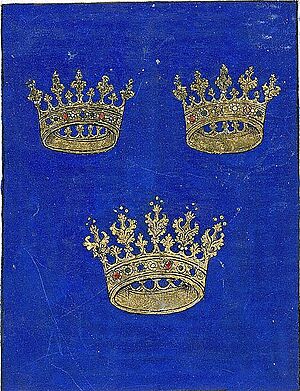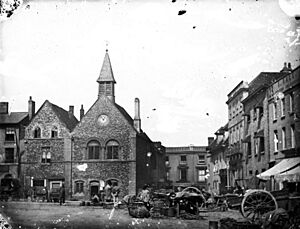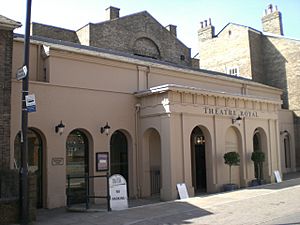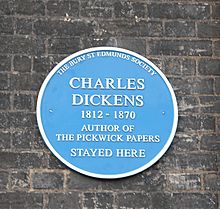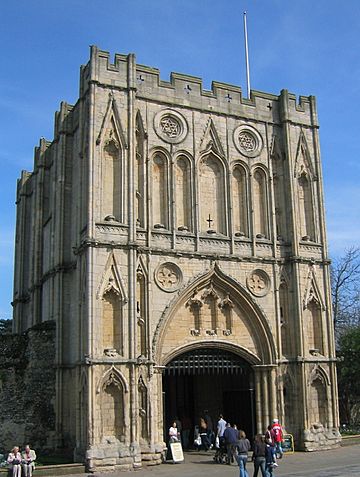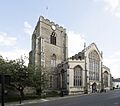Bury St Edmunds facts for kids
Quick facts for kids Bury St Edmunds |
|
|---|---|
| Town and Civil parish | |
|
Clockwise from top: Bury aerial view, Abbeygate Street, St Mary's Church, Abbeygate and Cathedral |
|
| Population | 48,000 (2011) |
| OS grid reference | TL855645 |
| Civil parish |
|
| District |
|
| Shire county | |
| Region | |
| Country | England |
| Sovereign state | United Kingdom |
| Post town | BURY ST. EDMUNDS |
| Postcode district | IP32, IP33 |
| Dialling code | 01284 |
| Police | Suffolk |
| Fire | Suffolk |
| Ambulance | East of England |
| EU Parliament | East of England |
| UK Parliament |
|
Bury St Edmunds (pronounced berry saint ed-munds), often called Bury, is a historic cathedral and market town in Suffolk, England. It's famous for its old Bury St Edmunds Abbey and St Edmundsbury Cathedral. The town is home to the main church of the Diocese of St Edmundsbury and Ipswich. In 2011, about 45,000 people lived here.
Bury was first called Beodericsworth. It was planned out in a grid shape around 1080. Today, it's known for making beer and for a factory that turns sugar beet into Silver Spoon sugar. Bury is a busy place for shopping and culture in West Suffolk, and many visitors come here.
Contents
What's in a Name?
The name Bury comes from an old word meaning 'fortress' or 'castle'. You can find similar words in other languages like German and Old Norse.
The second part of the name, St Edmunds, refers to Edmund the Martyr. He was a king of the East Angles who was killed by the Vikings in 869. People believed he was a saint and a martyr. His special burial place made Bury St Edmunds a very important spot for pilgrimage (religious journeys).
The official name for the church area is "St Edmundsbury," but most people just call the town Bury.
A Look Back in Time
Archaeologists have found signs of people living here since the Bronze Age. They also found Roman coins from the first and second centuries. Some old writers thought Bury St Edmunds might have been a Roman site called Villa Faustini, but there isn't much proof.
Bury was one of the important towns for the Saxons. A monastery was started here around 633. In 903, it became the burial place of King Edmund the Martyr. Because of the stories of miracles at his shrine, the town became very famous. By 925, the town's name changed to St Edmund's Bury.
In the 900s, kings gave the abbot (head of the monastery) and the monks control over the whole town. Later, Edward the Confessor made the abbot the lord of the area. The old monastery was replaced with a new one run by Benedictine monks.
The town had a thriving Jewish community for a while. In 1190, the Jewish community moved away from the town. This happened long before a similar event across England. In 1198, a fire damaged St Edmund's shrine, and his body was moved to a new spot in the abbey.
Bury St Edmunds is linked to the Magna Carta. In 1214, English barons are thought to have met in the abbey church. They swore to make King John agree to the Charter of Liberties. This document helped create the Magna Carta.
Over time, the town gained more rights from the abbots and became a borough. In 1327, there was a big riot where local people fought against the abbey. The main gate was destroyed, and a stronger one was built. In 1608, a "great fire" destroyed many homes and buildings in Eastgate Street.

By the 1300s, Bury became a busy town known for making cloth and trading wool. Later, kings like Elizabeth I and James I gave the town more special rights and charters.
From 1608, Bury St Edmunds could send two members to Parliament. The town and the surrounding area supported Puritan ideas in the 1600s. Many families left for the Massachusetts Bay Colony in America during this time. Bury's old grammar school taught important people like the writer Richard Sibbes and John Winthrop the Younger, who became a governor in America.
Modern Times
By 1841, the town's population reached over 12,500 people.
The military set up a permanent base here with barracks built in 1857 and 1878.
During the Second World War, the US Air Force used Rougham Airfield just outside the town.
Cool Places to See
Near the abbey gardens, you can find Britain's first street sign that lights up from the inside. It's called the Pillar of Salt and was built in 1935. This sign is at the end of the A1101, which is Great Britain's lowest road, mostly below sea level.
There are also tunnels under the town from old chalk-mining. They are not open to the public because they can be unsafe.
Some important buildings include St Mary's Church, Bury St Edmunds. This is where Mary Tudor, Queen of France, who was the sister of King Henry VIII, was re-buried. Queen Victoria later added a beautiful stained glass window to the church in Mary's memory. The Bury St Edmunds Guildhall is another old building, dating back to the late 1100s.
Bury St Edmunds has a full-time fire station run by Suffolk Fire and Rescue Service. It has moved locations a few times and is now on Parkway North.
Since 2015, Bury St Edmunds has been home to government offices that handle divorce documents and maintenance payments for London and the South East of England.
Where is Bury St Edmunds?
Bury is in the middle of a hilly area in East Anglia called the East Anglian Heights. Land to the east and west of the town rises to over 100 meters (328 feet). However, parts of the town itself are as low as 30 meters (98 feet) above sea level, where the Rivers Lark and Linnet flow through.
Weather
The weather in Bury St Edmunds is generally mild. The highest temperature ever recorded was 36.7°C (98.1°F) in August 2003. The lowest recent temperature was -10.0°C (14.0°F) in December 2010.
Rainfall is usually low, less than 600 millimeters (23.6 inches) per year, and it's spread out evenly throughout the year.
| Climate data for Brooms Barn 75m asl, 1991-2020 | |||||||||||||
|---|---|---|---|---|---|---|---|---|---|---|---|---|---|
| Month | Jan | Feb | Mar | Apr | May | Jun | Jul | Aug | Sep | Oct | Nov | Dec | Year |
| Mean daily maximum °C (°F) | 7.1 (44.8) |
7.7 (45.9) |
10.5 (50.9) |
13.8 (56.8) |
17.0 (62.6) |
19.9 (67.8) |
22.6 (72.7) |
22.3 (72.1) |
19.1 (66.4) |
14.7 (58.5) |
10.3 (50.5) |
7.5 (45.5) |
14.4 (57.9) |
| Mean daily minimum °C (°F) | 1.9 (35.4) |
1.8 (35.2) |
3.2 (37.8) |
4.8 (40.6) |
7.6 (45.7) |
10.5 (50.9) |
12.7 (54.9) |
12.7 (54.9) |
10.6 (51.1) |
7.9 (46.2) |
4.6 (40.3) |
2.3 (36.1) |
6.7 (44.1) |
| Average rainfall mm (inches) | 51.6 (2.03) |
41.7 (1.64) |
39.8 (1.57) |
40.0 (1.57) |
48.3 (1.90) |
56.9 (2.24) |
54.6 (2.15) |
65.7 (2.59) |
49.9 (1.96) |
61.0 (2.40) |
60.2 (2.37) |
57.6 (2.27) |
627.3 (24.69) |
| Average rainy days (≥ 1.0 mm) | 10.9 | 10.0 | 9.2 | 8.7 | 8.0 | 9.1 | 9.0 | 9.6 | 8.6 | 10.6 | 11.6 | 11.5 | 116.8 |
| Mean monthly sunshine hours | 62.2 | 76.4 | 121.3 | 170.5 | 207.6 | 198.1 | 208.1 | 194.6 | 152.4 | 114.5 | 70.0 | 57.5 | 1,633.2 |
| Source: Met Office | |||||||||||||
Churches and Faith
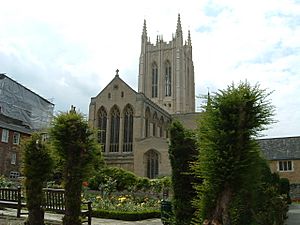
Bury St Edmunds has a long Christian history, starting with the abbey in 1020. Today, many churches are active in the town.
The Abbey
In the center of Bury St Edmunds, you can see the ruins of an abbey surrounded by beautiful gardens. This abbey was a special place for Saint Edmund, the Saxon King of the East Angles. The townspeople damaged the abbey in the 1300s, and much of it was destroyed in the 1500s. Even so, the town stayed successful for many years.
Anglican Churches
For a long time, the town only had two main churches: St James's and St Mary's. St James's is now the cathedral. Today, Bury has seven Anglican churches in six different areas.
The Cathedral
St James' parish church became St Edmundsbury Cathedral in 1914. The cathedral was made bigger in the 1960s. A new tower was built between 2000 and 2005 as a special project. The tower opened in July 2005 with a concert and fireworks. This makes St Edmundsbury the newest Anglican cathedral in the UK.
St Mary's Church
St Mary's Church is an important church for Bury St Edmunds and one of the largest parish churches in England. It was once part of the abbey complex. It's famous for its amazing "angel" roof. It's also the final resting place of Mary Tudor, Queen of France, who was King Henry VIII's favorite sister. St Mary's also has a special chapel for the Suffolk and Royal Anglian Regiments.
Other Anglican churches in town include:
- All Saints, Park Road (built 1953)
- Christ Church, Moreton Hall (founded 1983, built 1993)
- St George, Anselm Avenue (built 1951)
- St John, St John's Street (built 1840)
- St Peter, Hospital Road (built 1856-58)
Other Churches
Bury St Edmunds has many other churches and chapels:
- Baptist Church, Garland Street
- Beacon Church Bury St Edmunds, Oakes Road (an evangelical church)
- Bridge Community Church, West Road
- Horringer Court Community Church, Glastonbury Road
- Kingsgate Church, Grove Road
- Evangelical Presbyterian Church, St Olaves Road
- Quaker Meeting House, St John's Street
- Seventh Day Adventist Church, Fornham Road
- Southgate Church, Caie Walk
- Trinity Methodist Church, Brentgovel Street
- Unitarian Meeting House, Churchgate Street
- United Reformed Church, Whiting Street
- Westgate Chapel, Hospital Road
- West Suffolk Vineyard Church, Northern Way
Catholic Church
St Edmund's Catholic Church is on Westgate Street. It was started by the Jesuits in 1763. The current church building was built in 1837 and is a listed historic building.
Fun and Culture
The Theatre Royal was built in 1819. It's the only surviving Regency theatre in the country. The theatre is owned by the Greene King brewery and is looked after by the National Trust. It was restored between 2005 and 2007. It offers many shows and public tours. In August 2023, the theatre temporarily closed for fire safety checks.
The Apex is another arts venue built in 2010.
Moyse's Hall Museum is one of the oldest buildings in East Anglia open to the public, dating back to around 1180. It has collections of art, costumes, clocks, and local history.
The Market Cross is a historic building that was restored in the 1780s. Today, it's a community space. From 1972 to 2018, it was an art gallery called "Smiths Row."
The town hosts several festivals each year. The biggest one is in May, with concerts, plays, dance, and talks, ending with fireworks. Bury St Edmunds is also home to England's oldest Scout group.
Sports
The town's main football club, Bury Town, is the fourth oldest non-league team in England. They play at Ram Meadow.
Suffolk County Cricket Club plays some games at the Victory Ground, which is also home to Bury St Edmunds Cricket Club. Bury St Edmunds Rugby Football Club has a long history. Eastgate Amateur Boxing club started in 1981. West Suffolk Swimming Club and West Suffolk Athletics Club are also based here.
Nowton Park hosts a parkrun every Saturday morning, where people can run, jog, or walk for free. A junior parkrun for kids aged 4-14 is held every Sunday at Ten Acre Field. The Bury St Edmunds Pacers running club welcomes runners of all levels.
Local News
Local news and TV shows are provided by BBC East and ITV Anglia. You can listen to local radio stations like BBC Radio Suffolk and RWSfm. The local newspapers are the East Anglian Daily Times and Bury Free Press.
Local Businesses
Visitors Welcome!
The Angel Hotel is a beautiful Georgian building on Angel Hill. Famous writer Charles Dickens stayed there. Even Angelina Jolie stayed there while filming Tomb Raider. There has been an inn on this spot since the 1400s.
Brewing
Greene King, a large brewery, is located in Bury St Edmunds. The smaller Old Cannon Brewery is also here. Just outside town, you'll find Bartrums Brewery and Brewshed brewery.
The Greene King pub called The Nutshell is in the town center. It claims to be the smallest public house in Britain!
Sugar Factory
Bury's biggest landmark is the British Sugar factory near the A14. This factory turns sugar beet into refined crystal sugar. It was built in 1925. The factory processes beet from many local farmers. The sugar is sold under the Silver Spoon name. The factory also makes animal feed and a soil improver. It even has its own power station that powers many homes!
How the Town is Run
Town Council
The town council was created in 2003. In 2020, it was announced that the town council would meet in the Guildhall, which was the historic home of the borough council for many years.
District Council
Bury St Edmunds has been part of the West Suffolk district since April 2019. Before that, it was part of the St Edmundsbury district. West Suffolk Council has offices in Bury St Edmunds.
County Council
Bury St Edmunds has been part of the county of Suffolk since April 1974. Before that, it was the main town of the county of West Suffolk.
Parliamentary Representative
Bury St Edmunds is part of the Bury St Edmunds and Stowmarket area for Parliament. The current MP is Peter Prinsley from the Labour Party, who was elected in 2024.
Famous People from Bury St Edmunds
Many notable people are from Bury St Edmunds or have lived here. These include:
- Stephen Gardiner, a Bishop and Lord Chancellor.
- Humphry Repton, a landscape architect.
- Ouida, an author.
- Hiram Codd, an engineer and inventor.
- James Moore, a cyclist.
- Rose Mead, a portrait painter.
- Sybil Andrews, an artist.
- Helen Margaret Spanton, an artist and suffragette.
- Guy Simonds, a Canadian World War II general.
- Elizabeth Nel, Winston Churchill's secretary.
- Sir Peter Hall, a theatre director.
- Liam Gibbs, a footballer for Norwich City F.C.
- Richard Gwyn, a Canadian journalist.
- Actors Bob Hoskins and Michael Maloney.
- Speedway rider Danny Ayres.
- TV presenter Becky Jago.
- Writer and artist Chris Joseph.
- Writer/director Adrian Tanner.
- Children's writer A.M. Howell.
Other famous people who lived here include Thomas Clarkson, who worked to end slavery, and actor John Le Mesurier.
Notable bands and performers from Bury St Edmunds include Jacob's Mouse, Miss Black America, The Dawn Parade, Kate Jackson, and Paul Hopfensperger.
Some former members of Parliament and government ministers have chosen to live or have second homes in Bury St Edmunds, such as Lord Tebbit and Eldon Griffiths.
Learning and Schools
Primary and Secondary Schools
Bury St Edmunds has several state-funded primary schools, including Howard, Westgate, Hardwick, Sebert Wood, Abbot's Green, Sexton's Manor, Guildhall Feoffment, St Edmund's, St Edmundsbury, and Tollgate Primary Schools.
The town has four secondary schools: Bury St Edmunds County High School, King Edward VI School, St Benedict's Catholic School, and Sybil Andrews Academy.
In 2019, the town's first Sixth Form College, Abbeygate Sixth Form College, opened.
The closest private school is Culford School, just north of town. South Lee School is an independent preparatory school.
Higher Education
West Suffolk College is the town's largest provider of further education, with over 10,000 students. The college has expanded to include a new teaching center for energy, engineering, and manufacturing. Since 2015, students can also study university degrees at the University of Suffolk at West Suffolk College.
Getting Around
Bury St Edmunds railway station serves the town. Trains run every day to Peterborough, Ipswich, and Cambridge. From Cambridge, you can connect to London King's Cross, London Liverpool Street, and Stansted Airport. From Ipswich, you can connect to London Liverpool Street.
The main place for buses and coaches is the bus station on St Andrews Street North. Buses connect the town center to residential areas. There are also regular bus services to nearby towns like Brandon, Cambridge, Ipswich, and Newmarket. National Express coaches also stop here, connecting Bury to London and other major cities.
Sister Cities
Bury St Edmunds is connected with these towns around the world:
Other Connections
- HMS Vengeance: A Royal Navy submarine.
Bury in Books
Bury St Edmunds is mentioned in the ghost story The Ash-tree by M.R. James, published in 1904.
Author Norah Lofts based many of her stories in "Baildon," which is a made-up version of Bury St Edmunds, where she went to school and lived.
Images for kids
See also
 In Spanish: Bury St Edmunds para niños
In Spanish: Bury St Edmunds para niños


